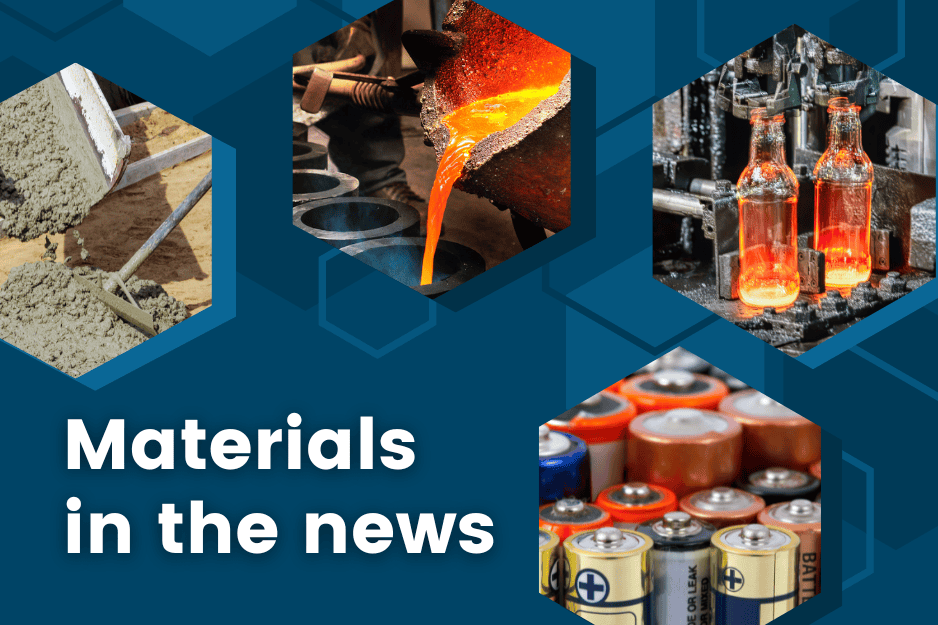
[Image above] Credit: ACerS
NANOMATERIALS
Rocket-inspired reaction yields carbon with record surface area
Cornell University researchers engineered a nanoporous carbon with the highest surface area ever reported (4,800 square meters per gram) using a synthesis technique based on a hypergolic reaction.
Engineers discover new ‘all-optical’ nanoscale sensors of force
Columbia University researchers developed luminescent nanocrystals that can change intensity and/or color when probed with light, therefore allowing for fully remote read-outs without wires or connections.
ENERGY
Sodium-cooled prototype fast breeder reactor could boost energy production
Bharatiya Nabhikiya Vidyut Nigam Limited developed a 500 MWe nuclear reactor that uses fast neutrons for energy generation and employs liquid sodium as a coolant instead of water. This innovative design allows the reactor to “breed” more fuel than it consumes.
Diamond-based nuclear-powered battery
Physicists and chemists from the University of Bristol grew a man-made diamond that, when placed in a radioactive field, can generate a small electrical current. They are working to improve efficiency by using carbon-14, a radioactive version of carbon, which is generated in graphite blocks used to moderate the reaction in nuclear power plants.
Sodium vanadium phosphate improves sodium-ion battery performance
An international team of researchers, including the University of Houston, showed that sodium vanadium phosphate improves sodium-ion battery performance by increasing the energy density by more than 15%.
New superionic conducting electrolyte enhances stability of all-solid-state lithium-metal batteries
Researchers led by Western University and the University of Maryland designed a vacancy-rich and superionic conducting β-Li3N solid-state electrolyte that could enable stable cycling of all-solid-state lithium metal batteries.
Solar powered self-charging supercapacitors for renewable energy applications
Researchers led by Daegu Gyeongbuk Institute of Science and Technology and Kyungpook National University developed a self-charging supercapacitor system by integrating solar energy technology with advanced supercapacitors. The resulting device demonstrated an energy density of 35.5 Wh kg.
BIOMATERIALS
Individual atoms in tooth enamel reveal what happens to our teeth as we age
Researchers at the University of Washington and Pacific Northwest National Laboratory examined the atomic composition of enamel samples from two human teeth: one from a 22 year old and one from a 56 year old. The sample from the older person contained higher levels of the ion fluoride, which is often found in drinking water and toothpaste.
ENVIRONMENT
‘Living’ ceramics use bacteria for gas sensing and carbon capture
A team of materials scientists and chemists at ETH Zürich developed a multistep process to grow bacteria in a ceramic material, thus allowing it to detect small amounts of formaldehyde and capture carbon dioxide from the air.
New titanium-based structures show improved carbon capture ability
Oregon State University researchers synthesized titanium peroxide molecules that can quickly capture significant amounts of carbon dioxide from the air. The measured carbon capture capacity was about 8.5 millimoles carbon dioxide per gram of potassium tetraperoxo titanate—roughly double that of vanadium peroxide.
Feasting fungi could revolutionize carbon fiber recycling
Researchers at the University of Kansas and the University of Southern California developed a chemical procedure for breaking down and removing the matrix from carbon fiber reinforced polymers such that recovered carbon fiber plies exhibit mechanical properties comparable to those of virgin manufacturing substrates.
Novel materials with almost perfect water repellency
Researchers from Karlsruhe Institute of Technology and Indian Institute of Technology Guwahati developed a metal-organic framework that repels water droplets almost completely by grafting hydrocarbon chains onto it. The superhydrophobic properties are interesting for use as self-cleaning surfaces that need to be robust against environmental influences.
MANUFACTURING
Engineers grow ‘high-rise’ 3D chips
Massachusetts Institute of Technology researchers designed a multilayered chip that does not require any silicon wafer substrates and works at temperatures low enough to preserve the underlying layer’s circuitry.
Scotch tape enables creation of diamond thin films
Researchers at the University of Hong Kong showed that Scotch tape can be used to peel off thin films of diamond from a silicon wafer that were deposited using chemical vapor deposition.
3D-printed structures for use in military operations
Researchers at the University of Nevada, Reno are collaborating with the U.S. Army Engineer Research and Development Center to create 3D-printed LEGO-like concrete modules that can be used to construct structures in mission zones.
Unlocking the hidden power of boiling
Massachusetts Institute of Technology researchers are shedding light on the physics of boiling to improve the efficiency of heat transfer in industrial systems.
The role of ovens in battery production: Advanced thermal processing technologies
An AZoM article overviews the types of ovens used in battery production to ensure battery performance, safety, and durability.
OTHER STORIES
Physicists magnetize a material with light
Massachusetts Institute of Technology researchers used a terahertz laser to directly stimulate atoms in an antiferromagnetic material. The results provide a new way to control and switch antiferromagnetic materials.
Unraveling the optical anisotropy of bismuth-based copper oxide superconductors
Researchers used ultraviolet and visible light transmittance techniques on lead-doped bismuth-based copper oxide single crystals, uncovering the source of the material’s anisotropy and paving the way for a deeper understanding of its superconducting mechanisms.
Surprise vortex loop quasiparticles may exist in all magnetic materials
University of Missouri researchers discovered a new type of quasiparticle that appears to be found in all magnetic materials. This discovery shows that magnetism is not as static as once believed.
Macroscopic oscillators move together at the quantum level
Researchers successfully prepared six mechanical oscillators in a collective state, observed their quantum behaviour, and measured phenomena that only emerge when oscillators act as a group.
First demonstration of quantum teleportation over busy internet cables
Northwestern University engineers demonstrated quantum teleportation over a fiber-optic cable already carrying internet traffic. The discovery introduces the possibility of combining quantum communication with existing internet cables.
Quantum computing method may make simulating materials more practical
Researchers recently described a more efficient method for using quantum computers to simulate materials. They introduced the use of pseudopotentials to simplify simulations of atomic core interactions, improving accuracy while lowering the computational cost.
Author
Lisa McDonald
CTT Categories
- Weekly Column: “Other materials”